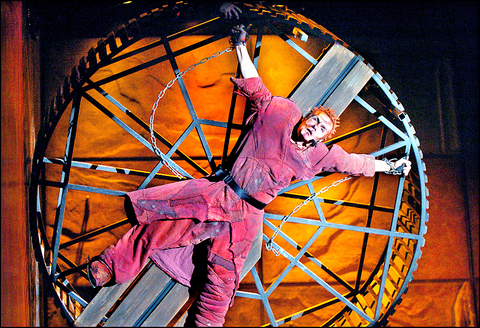Given the huge success of Victor Hugo's Les Miserables as a musical, it was only a matter of time before the French novelist's 1831 tale of love and betrayal, Notre Dame de Paris, hit the stage. Hollywood produced a film version in the 1930s, and Disney created an animation; but not until the mid-1990s did the tragedy become a major French language musical. Now on its first Asian tour the production will run for 10 days at the Sun Yat-sen Memorial Hall in Taipei.
French-Canadian Lu Plamondon made a name for himself as a lyricist writing songs for Celine Dion before he started composing rock operas in the seventies. After his box office hit Starmania in 1979, he combined his talent for writing lyrics with Italian composer Richard Cocciante's talent for writing music. The two worked on the Notre Dame project for three years before joining forces with dance theater director Gilles Maheu.
Notre Dame de Paris was first staged in France in 1998 and with a cast of European and Canadian musicians it achieved record-high ticket sales in its first year of production. Equally popular is the DVD and album version starring musicians Daniel Lavoie and Bruno Pelletier. An English translation of the show with guest appearance by Celine Dion was performed in the UK and the US but never reached the same level of success as its French predecessor.

PHOTO COURTESY OF NEW ASPECT
The cast has evolved since its first staging seven years ago but still boasts a number of established actors and musicians. French songstress Nadia Bel stars in the lead role as Esmeralda alongside Canadian vocalist Matt Laurest as Quasimodo.
More than 50 songs are included in the repertoire producing a show almost entirely told through song and dance with a few interpolations of dialogue. The choreography blends classical, street and acrobatic styles and complements the costume design, which also combines period pieces with modern-day themes. Set in 15th-century Paris the legendary Notre Dame cathedral is a fitting backdrop to the story.
Remaining true to Hugo's novel, Plamondon does not conceal its tragic outcome behind a happy ending. The show's narrator, Gringoire, sets the mood by opening with a song about changing values and emerging public unrest in the city. Exploring themes of love and prejudice, the story focuses on the ill-fated Esmeralda, a beautiful gypsy dancer from Spain and the deformed bell-ringer Quasimodo.
Phoebus, captain of the king's cavalry, is set to wed Fleur De Lys, but when his eyes fall upon the Spanish dancer his heart becomes torn between the captivating woman and his duty to Fleur De Lys and his country.
A callous priest Frollo and the naive hunchback Quasimodo are also in love with the young woman. The priest, unable to have her for himself, becomes consumed by jealousy. Accused of a crime she did not commit, Esmeralda is thrown in jail. Murder and betrayal ensue as the story reaches its climax and heartrending conclusion.

Exceptions to the rule are sometimes revealing. For a brief few years, there was an emerging ideological split between the Democratic Progressive Party (DPP) and Chinese Nationalist Party (KMT) that appeared to be pushing the DPP in a direction that would be considered more liberal, and the KMT more conservative. In the previous column, “The KMT-DPP’s bureaucrat-led developmental state” (Dec. 11, page 12), we examined how Taiwan’s democratic system developed, and how both the two main parties largely accepted a similar consensus on how Taiwan should be run domestically and did not split along the left-right lines more familiar in

As I finally slid into the warm embrace of the hot, clifftop pool, it was a serene moment of reflection. The sound of the river reflected off the cave walls, the white of our camping lights reflected off the dark, shimmering surface of the water, and I reflected on how fortunate I was to be here. After all, the beautiful walk through narrow canyons that had brought us here had been inaccessible for five years — and will be again soon. The day had started at the Huisun Forest Area (惠蓀林場), at the end of Nantou County Route 80, north and east

Specialty sandwiches loaded with the contents of an entire charcuterie board, overflowing with sauces, creams and all manner of creative add-ons, is perhaps one of the biggest global food trends of this year. From London to New York, lines form down the block for mortadella, burrata, pistachio and more stuffed between slices of fresh sourdough, rye or focaccia. To try the trend in Taipei, Munchies Mafia is for sure the spot — could this be the best sandwich in town? Carlos from Spain and Sergio from Mexico opened this spot just seven months ago. The two met working in the

This month the government ordered a one-year block of Xiaohongshu (小紅書) or Rednote, a Chinese social media platform with more than 3 million users in Taiwan. The government pointed to widespread fraud activity on the platform, along with cybersecurity failures. Officials said that they had reached out to the company and asked it to change. However, they received no response. The pro-China parties, the Chinese Nationalist Party (KMT) and Taiwan People’s Party (TPP), immediately swung into action, denouncing the ban as an attack on free speech. This “free speech” claim was then echoed by the People’s Republic of China (PRC),